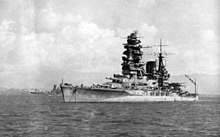Nagato (ship, 1919)
|
Drawing of the Nagato after the renovation
|
||||||||||||||||||
|
||||||||||||||||||
|
||||||||||||||||||
|
||||||||||||||||||
|
||||||||||||||||||
The Nagato ( Japanese : 長 門), named after the ancient Nagato province , was a battleship of the Japanese Navy that was used in World War II . She was the lead ship of the two-unit Nagato class named after her .
General data
- Start of construction: August 28, 1917, Kure shipyard , Kosho
- Launched: November 9, 1919
- Commissioned: November 1920
- Rebuilding: 1936
- Fate: capsized on July 29, 1946 as a result of the Baker nuclear test on July 24, 1946 in Bikini Atoll.
Mission history of the Nagato
After its commissioning in 1920, the Nagato was the first battleship to be equipped with the world's most powerful 41 cm guns at the time.
On December 2, 1941, on instructions from Admiral Yamamoto, the Nagato radio room set signal 676 Climb Mount Nitaka 1208 - the order for Admiral Nagumo's aircraft carrier to attack the US naval base at Pearl Harbor .
During the Battle of Midway in June 1942, the Nagato was deployed a few hundred nautical miles behind the aircraft carriers and had no contact with the enemy. Later she mainly carried out transport and exercise missions.
During the battle in the Philippine Sea , the Nagato belonged to the combat group of the aircraft carrier Hiyo , but suffered no damage or losses in the air raids against the association. Their main guns fired for the first time on formations of approaching US torpedo bombers.
In July 1944, the Nagato was equipped with simple radars and an infrared detection system and shortly afterwards transported the 36th regiment of the 28th Division to Saipan .
In October 1944, the Nagato took part in the Battle of the Leyte Gulf . Their combat group shelled Admiral Sprague's escort aircraft carriers in the battle of Samar. It was damaged by several air strikes and around 40 of its crew were killed.
The Nagato was then withdrawn to Kure via detours, together with the battleships Yamato and Kongo , and did not take part in any further operations due to limited fuel supplies and lack of success.
On June 1, 1945, most of the Nagato's anti-aircraft weapons , rangefinders, and searchlights were dismantled and rebuilt on nearby mountains. The flak crews were withdrawn. The Nagato was completely camouflaged from the view of airmen, for which purpose the chimney was removed.
On July 18, 1945, the Nagato was attacked by American carrier aircraft and damaged by bombs on the bridge and on deck. Rear Admiral Ōtsuka Miki and 50 other men were killed in the air strike.
Surrender and Destruction
After the Japanese surrender on September 2, 1945, Nagato was taken over by the USA .
After it was taken over by the US Navy , it was first transferred to Eniwetok and later to Bikini Atoll and anchored there. She now belonged to a group of unmanned target ships on which the effectiveness of nuclear weapons was to be tested in Operation Crossroads . After surviving the dropping of an atomic bomb over the atoll relatively unscathed in the Able test , she was severely damaged by another atomic bomb, this time detonated at a depth of 27 m, the Baker test . A few days later, on July 29, 1946, so much water had collected in the ship that it capsized and sank to the bottom. The Nagato was as other target ships also difficult in this Test contaminated .
The fact that the ship sank so slowly led to the realization that a heavily armored warship equipped with a powerful anti-leak system could have withstood such a hit - even if the crew in the unprotected superstructure and on deck fell victim to the radiation would.
wreck
The Nagato wreck lies keel up in Bikini Atoll at a depth of approx. 50 m. As the radiation has decreased significantly, recreational divers can now dive it for a limited time.
Under the wreck of Nagato is ionizing radiation still increased.
Evidence and references
Remarks
- ↑ a b as in 1946 determined on the basis of Japanese documents in Report X-39 (N), Miscellaneous Reports of Various Japanese Naval Research Activities, p. 29
Individual evidence
- ↑ Skwiot, p 46
- ↑ Potter, Rohwer, Nimitz: Seemacht , Munich 1974 p. 916 ISBN 3-7637-5112-2
- ↑ TV broadcast of the Süddeutsche Zeitung
literature
- Gakkan (publ.), Nagato Class, Pacific War Series, No. 15, ISBN 4-05-601684-4 , 1998 (Japanese)
- Skwiot, Mirosław (2007). Nagato, Mutsu. Vol. 1. Encyklopedia okrętów wojennych, 51. Gdańsk, Poland: AJ-Press. ISBN 978-83-7237-184-3 .

